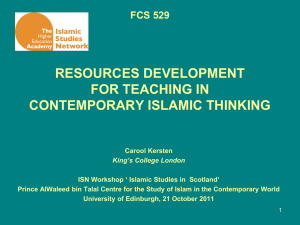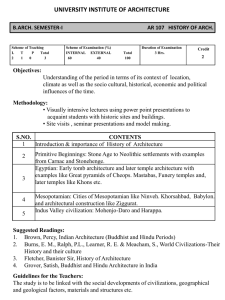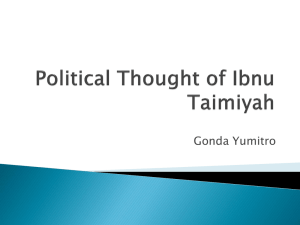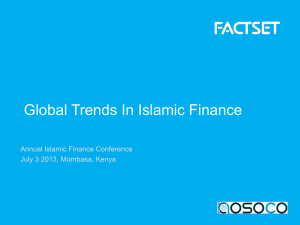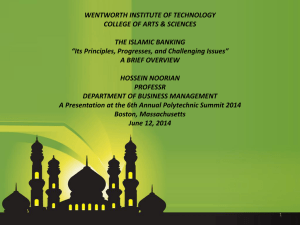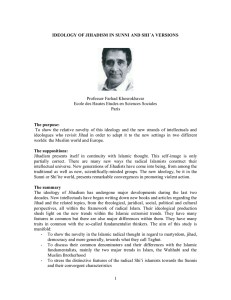Islamic Mathematicians
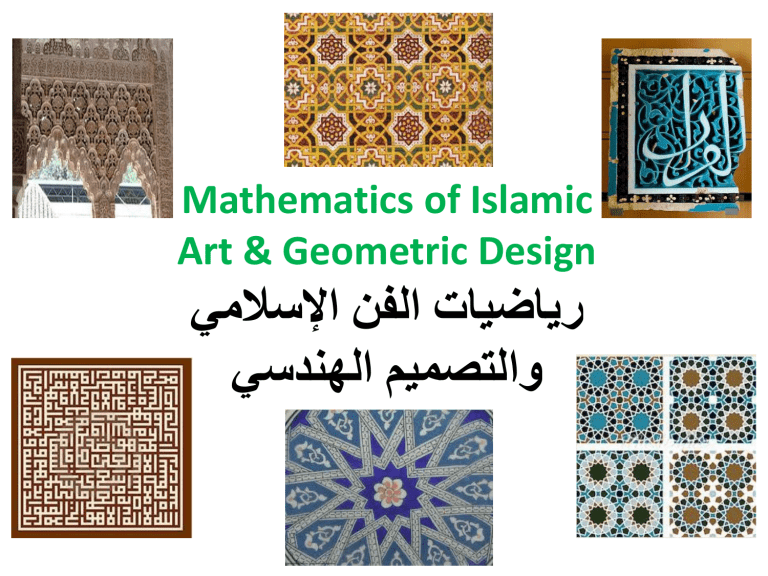
Mathematics of Islamic
Art & Geometric Design
يملاسلإا نفلا تايضاير
يسدنهلا ميمصتلاو
Learning Objectives:
• To raise awareness of
Islamic contribution to
Mathematics
• To inspire Mathematics through the study of
Islamic Geometric Designs
• To have fun with Islamic
Geometric Designs
• To create works of art
Formative Assessment to Determine
Knowledge Base to Track Progress
1.
After which Muslim Mathematician is the term “algorithm” named?
A. al-Karaji B. al Khawrizmi C. al Biruni D. al Jazari
2.
Which Muslim Mathematician is regarded as the “Father of Optics”?
A. al-Mawsili B. al Jurjani C. ibn Haytham D. al Firnas
3.
Which Muslim Polymath is regarded as the first aviator?
A. ibn Firnas B. ibn Battuta C. Hasan Selebi D. al Kindi
4.
Which Muslim Mathematician, philosopher, musician and physicist has been described as one of the “Twelve great minds of history”?
A. ibn Haytham B. al Wafa C. al Rammah D. al Kindi
5.
Which Italian Mathematician played a major role in promoting the use of Arabic numbers in Europe?
A. Galileo B. de Vinci C. Fibonacci D. di Capprio
Thabit bin Qurra: ibn al-Haytham
Kamal al-Din al-Farisi’s work
Algebra, Geometry
Greatest Muslim geometer
نيملسملا تايضايرلا ءاملع رهشأ
Famous Muslim mathematicians
Omar Khayyam: Poet,
Mathematician, Astronomer
Muhammad Al-Karaji’s work
Al-Khwarizmi
The “Father of Algebra”
Al-Khwarizmi
The “Father of Algebra”
• The best known of the Islamic
Mathematicians
• Considered one of the greatest
Mathematicians of all times
• His books were studied long into the Renaissance
• To him we owe the words:
Algebra and Algorithm
Al-Karaji
• Al-Karaji was the first to use mathematical induction to prove the binomial theorem
– He proved that if the first statement in an infinite sequence of statements is true, then so is the next one .
He proved that: If (1 3 + 2 3 ) = (1 +2) 2
Then (1 3 + 2 3 + 3 3 ) = (1 +2 + 3) 2 and so on and so on
Omar Al Khayyam
• Famous poet and the writer of the “ Rubaiyat ”, but an important mathematician and astronomer in his own right
The Moving Finger writes, and, having written,
Moves on: nor all thy Piety nor Wit
Shall lure it back to cancel half a Line,
Nor all thy Tears wash out a Word of it.
Nasir Al-Din Al-Tusi
• The first to treat trigonometry as a separate math discipline, distinct from astronomy
• Gave the first extensive account of spherical trigonometry
• One of his major mathematical contributions was the formulation of the famous law of sine for plane triangles: a ⁄
(sin A)
= b ⁄
(sin B)
= c ⁄
(sin C)
ibn Al-Haytham
• Systemized conic sections and number theory on analytic geometry
• Worked on the beginnings of the link between algebra and geometry
• This in turn had an influence on the development of René
Descartes' geometric analysis and Isaac Newton's calculus .
Kamal Al-Din al-Farisi
• Applied the theory of conic sections to solve optical problems
• Pursued work in number theory such as on amicable numbers (e.g.,
220 & 284)
• Factorization of an integer into powers of prime numbers
Thabit bin Qurra
• Greatest Muslim geometer
• Played an important role in preparing the way for mathematical discoveries :
– extension of the concept of number to (positive) real numbers, integral calculus , theorems in spherical trigonometry, analytic and non-
Euclidean geometry
• Was one of the first to create a new proof for the Pythagorean
Theorem
Astrolabe
• The Astrolabe was highly developed in the Islamic
World by 9th Century
• It was introduced to
Europe from Islamic
Spain (Al Andalus) in the early 12th Century
• It was the most popular astronomical instrument until about 1650
What is Taught and What Should be Taught?
What is Taught: What Should be Taught:
Francois Vieta was the first to utilize algebraic symbols.
Muslim mathematicians invented algebra.
In 1591, he wrote an algebra book describing equations with letters.
In early 9th century, they introduced the concept of using letters for unknown variables in equations.
What is Taught and What Should be Taught?
What is Taught:
In 1614, John
Napier invented logarithms and logarithmic tables.
What Should be Taught:
Islamic Mathematicians invented logarithms and produced logarithmic tables.
These were common in the Islamic world as early as the 13th Century.
What is Taught and What Should be Taught?
What is Taught:
The use of decimal fractions in mathematics was first developed by a Dutchman, Simon
Stevin, in 1589.
What Should be Taught:
Al-Kashi's book, Key to
Arithmetic, was the stimulus for the application of decimals to whole numbers and fractions.
It was written at the beginning of the 15th century.
What is Taught and What Should be Taught?
What is Taught:
The concept that numbers could be less than zero was unknown until 1545 when Cardano introduced the idea.
What Should he Taught:
Muslim mathematicians introduced negative numbers for use in arithmetic functions at least 400 years prior to
Cardano.
Mathematics of Islamic
Art & Geometric Design
Islamic art explores the geometric systems of the regular division of the circle
Islamic Art increases appreciation and understanding of geometry
Working only with a ruler and compass, students can discover how to create and study many of the geometric designs
Circles, Squares & Octagons
The eight-points star, made of two overlapping squares in a circle, is the basis of many Islamic patters
Seven overlapping circles
Discovering Patterns with Triangle Grid
Discovering Patterns with Five Overlapping
Circle Grids
Discovering Patterns with the Diagonal Grid
Activities based on geometric Islamic patterns can support learning about shapes, spaces and measures
• In Primary, students can learn to draw and recognise circles, triangles, squares, hexagons and octagons
• Create pictures using 2-D shapes
• Learn to identify lines of symmetry
• Recognise reflective and rotational symmetry
• Upper Primary and Middle school students can study symmetric patterns to produce tessellations .
• High school students can look at molecular & crystal shapes and calculate spaces occupied
Work of AAM Students
http://cmcuworkshops.net/?page_id=13
http://www.dynamicgeometry.com/
Review of Math topics using Jigsaws and
Islamic Geometric Designs
Formulator Tarsia is designed for Teachers of Mathematics to create activities in a form of jigsaws for use in a class. It includes the powerful equation editor for building the math-expressions for the activities .
http://www.mmlsoft.com/index.php?option=com_content&task=view&id=9&Itemid=10
3-D Applications (G&T Projects)
A few References on Islamic Art & Math
• Islamic Art and Geometric Design: Activities for Learning Copyright ©2004 by The
Metropolitan Museum of Art, New York: http://www.metmuseum.org/~/media/Files/Learn/For%20Educators/Publications%20for%2
0Educators/Islamic_Art_and_Geometric_Design.pdf
• Mathematics, Geometry and the Arts Resources (under: Islamic Art and the Sciences) http://cmcuworkshops.net/?page_id=13 ; http://www.dynamicgeometry.com/
• Islamic Art & Culture: A resource for Teachers http://ahmadladhani.files.wordpress.com/2009/10/islamic-tp1.pdf
• The connection between Islamic art and Mathematics http://www.dartmouth.edu/~matc/math5.pattern/lesson5A&M.connection.html
• Using Technology to investigate mathematics in Islamic Art: http://cmcuworkshops.net/?page_id=13
• Formulator Tarsia known earlier as Formulator Jigsaw is an editor designed for Teachers of
Mathematics creating the activities in a form of jigsaws or dominos etc for later use in a class. It includes the powerful equation editor for building the math-expressions for the activities.
http://www.mmlsoft.com/index.php?option=com_content&task=view&id=9&Ite mid=10
• Book of Curiosities of the Sciences and Marvels of the Eyes http://cosmos.bodley.ox.ac.uk/store/Teacher_s-Pack-Inside-pages.pdf
• Islamic Geometric Patterns by Eric Broug, published by Thames & Hudson
• Geometric Concepts in Islamic Arts by El-Said
• Islamic Design: A Genius for Geometry (Wooden Books) by Daud Sutton
Learning Objectives:
• To raise awareness of
Islamic contribution to
Mathematics
• To inspire Mathematics through the study of
Islamic Geometric Designs
• To have fun with Islamic
Geometric Designs
• To create works of art



